Carpenter bees derive their name from their ability to drill perfectly round holes in exposed wood to make nests. The bees drill and burrow 1/2 inch diameter holes using their strong broad mandibles (jaws).
They have many interesting attributes, traits, and habits. Some of which are not very popular with homeowners! Let’s dig (pun intended) into some interesting facts about carpenter bees.
1. Carpenter bees don’t eat wood
Carpenter bees don’t eat wood for nutrition; they only chew into dead but non-decayed limbs or trunks of standing dead trees to drill holes.
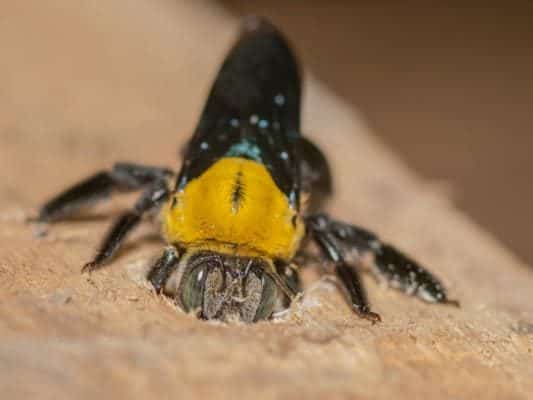
They also enjoy timber structure with weathered, unpainted wood especially softer varieties such as redwood, cedar, cypress, and pine. They have powerful pointy mouthparts also known as mandibles; which they use to drill and tunnel through even the tough plants such as bamboo.
Insects rely on their mandibles to grasp things and pick them up, or for more convenient activities like cutting up plants and food, building nests, and digging through dirt.
By positioning her body on a wooden surface, the female carpenter bee goes to work drilling holes. She rasps her mandibles against the wood and vibrates, tearing through the wood’s fibers following a circular pattern. She patiently removes one small piece at a time.
It takes a few days for a small hole to form that’s only 1/2 inch in diameter, just big enough for the bee to squeeze into. The drilling process generates sawdust that the bee later reuses when building and partitioning galleries in the tunnel to store her eggs.
2. There Is No Queen Carpenter Bee
Carpenter bees are solitary insects and do not live in colonies like honey bees. They don’t have a caste social system where you would find a task specific society such as in eusocial insects; bumblebees or honey bees. There are no queen or worker castes.
The adults live a solitary life but the females can share a nest. They overwinter individually, most times in previously constructed brood tunnels where they have stored limited pollen to survive the colder temperatures.
3. Male Carpenter Bees Fight Dirty, Including Head butts
Male carpenter bees are territorial. They appear to be aggressive as they fly around people and pets, but they are harmless since they do not have a stinger. They stake out and protect their territory from other carpenter bees and predators.
They can dive-bomb your head and buzz around a short distance in front of your face if you approach their nests too closely.
These actions are just a show meant to intimidate and drive off intruders and other carpenter bees from a territory. When they fight other male carpenter bees they head butt in mid-flight crashing into each other. Because of their big size, they appear quite threatening when they perform these maneuvers.
4. Female Carpenter Bees Are Expert Engineers
To build their nests, they first drill a hole of 1/2 inch in diameter in wood, preferably thick wood of more than 2 inches width. It takes 5 to 6 days for the female carpenter bee to drill and excavate just 1 inch of wood.
The Penn State College Of Agricultural Sciences has some interesting research insights into the engineering feats of these insects as they work on wood.
The female carpenter bee can squeeze through incredibly tiny places to bore into untreated wood. They make a 90 degree turn after drilling and excavating holes of 1 to 2 inches, then they drill a tunnel parallel to the wood surface. The tunnel runs along the wood grain to form a gallery about 6 inches long.
This gallery can sometimes be up to four feet long or more because carpenter bees have a tendency to come back year after year, to the same nest sites. They can excavate and expand the same site quite extensively to form galleries.
The long channel after the right angle turn serves as the main corridor from which she will drill small chambers a few inches deep which become egg holders.
In each chamber, she will deposit an egg on top of a mass of pollen and regurgitated nectar. She will then seal off the chamber to ensure the egg’s further development. The female bee forms partitions between each egg cell by mixing sawdust and saliva.
The partition walls closely resemble particle boards. Working back to front, the bee leaves each cell with a ball of pollen and a single egg.
5. Carpenter Bees Live In A Family Home, Sort Of…
Although carpenter bees are traditionally considered as solitary insects, some species cohabit in simple social nests, but just mothers and daughters may cohabit.
Two species seen to exhibit this social nesting behavior are Xylocopa sulcatipes (Arabian bee) and Xylocopa nasalis (widely found in Southeast Asian countries).
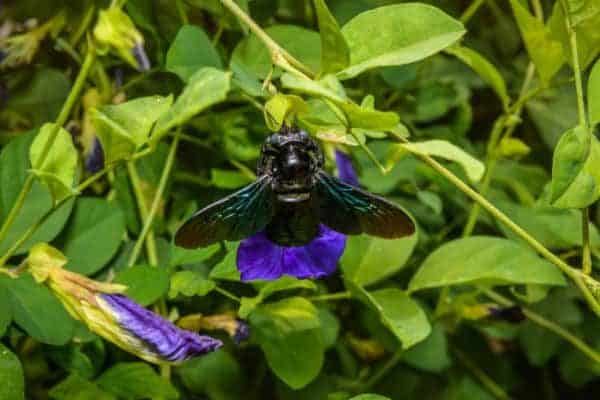
6. How You Can Tell You Have A Carpenter Bees Nest
Carpenter bees usually find their favorite sites for drilling holes on the unpainted underside of any wood surface including fascia boards, overhangs, soffits and window frames, outdoor furniture, and eaves. Other places are rafters, siding, wood shake roofs, and decks.
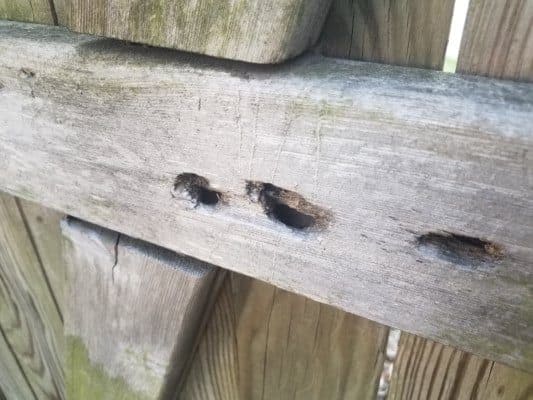
Underneath the round holes that the bees drill you will see coarse sawdust-like substances called frass. You may find old holes near the newer ones that the carpenter bees can use year after year.
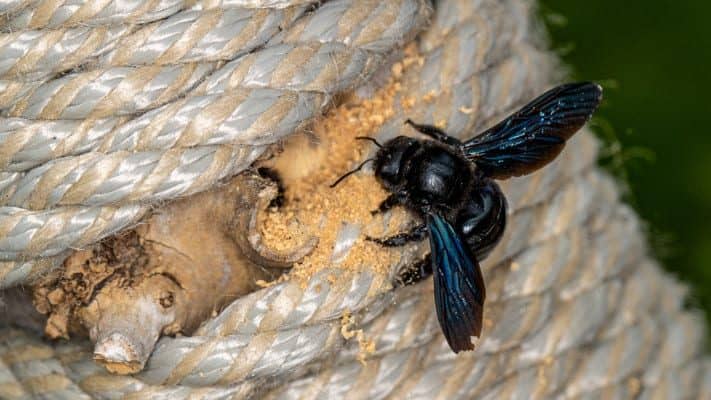
More signs are brownish or yellow excrement stains below the entrance hole to the galleries. Also if you notice many bees hovering around wooden or timber structures, especially if they are not painted, it could be a sign of carpenter bees infestation.
We have an article that discusses in detail how carpenter bees drill holes and the risks to the structures around your property that carpenter bees can pose. The article is called, How Do Carpenter Bees Drill Holes? It’s Worse Than You Think
7. Can Carpenter Bees Cause Structural Damage To Your House?
Carpenter bees are not considered a true structural pest because they do not spread throughout the entire structure. For example, termites are quite destructive on woodwork.
Carpenter bees tend to infest the same pieces of timber year after year, and because they excavate and expand the galleries in the wood, this can occasion significant damage.
Holes in the wood can allow moisture intrusion, rot, and decay. The large larvae developing in the wood tunnels attract woodpeckers who seek out the larvae and cause more damage.
The woodpecker’s peck and drill holes along the tunnels to get at the bees and larvae. The other natural predators of the bees are bird species such as shrikes and bee-eaters.
In the short term, the damage created by carpenter bees is more cosmetic than structural; however if not treated in time serious damage can happen over the years as the bees keep coming back and expanding the nests.
To find out more about How Do Carpenter Bees Drill Holes? It’s Worse Than You Think, follow the link for detailed information.
8. Carpenter Bees Vibrate To Pollinate
When it comes to the pollination of plants, few insects on the planet can match the honey bee species prowess as pollinators; however, the carpenter bee also plays a significant role in pollination.
As Pollinators, carpenter bees are important on some open-faced or shallow flowers. They are excellent pollinators of eggplant, tomato, and other vegetables. They are generalists in the pollination of our vegetable and flower gardens and may be found foraging on a number of different species.
They are early morning foragers, just like bumblebees. For some flowers they are even obligate pollinators, meaning they are the only insects that pollinate these plants. Some examples of such plants are maypop, purple passion, and opium (sea rose) which are not pollinated by any other insects.
Carpenter bees use their powerful thoracic muscles to sonicate the dry pollen grains out of the flowers’ anthers. This type of pollen gathering is called ‘buzz pollination”, with bees landing on flower blossoms becoming like living tuning forks. This action shakes loose pollen grains that end up sticking on the bees’ hairs.
The Carpenter bees have short mouthparts; hence they cannot reach the nectar of long tubed flowers. Also due to their large size, they are unable to enter the flower openings of certain flowers such as salvias, penstemons, and other long tubular flowers.
So the carpenter bee resorts to ingeniously robbing the nectar. Using their mouthparts they cut a slit at the base of the corolla and steal away with the nectar.
In this process, more often than not, they don’t pollinate the flower because they miss contact with the anthers that hold pollen.
We have an entire article dedicated to how bees pollinate plants if you are interested. We also cover what flowers are doing to attract bees and how bees are seeing flowers. The article is called, How Do Bees Pollinate?
9. Mating Trends/System
The males seek out the females during spring and can be seen hovering around nests. All females are fertile and can mate. The species Xylocopa Varipuncta, widespread in the western United States, has an unusual mating system.
The males are green-eyed and golden while the females are all black and have huge glands in their thoraces.
Territorial males choose non-flowering plants near other males and take up positions. They then as a group, actively release their rose-scented blend of chemicals. This attracts females from downwind who then choose a male with which to mate.
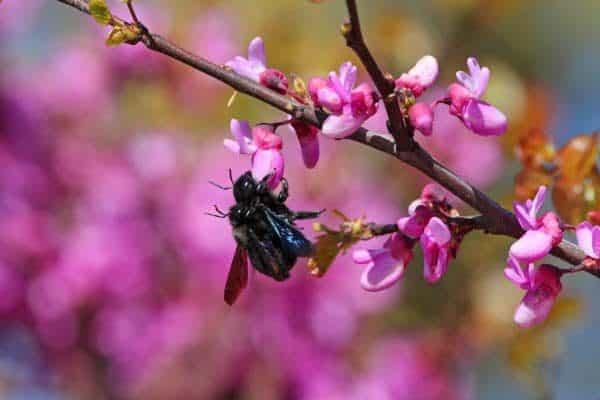
Fertilized female carpenter bees then bore into wood, excavating galleries to lay their eggs. The eggs hatch and mature in about 36 days.
The stored pollen serves as a food source for the developing larvae. The new mature generation of adult bees emerges in summer and begins foraging on flowers.
10. Carpenter Bees Sting, But It Is Rare. This Is Why
These bees are generally non-aggressive and for the most part, mind their own business without being a threat to people.
The females do sting although it is very rare. The bees stay near the nests which hold their eggs. You are unlikely to encounter them unless you disturb their nest which they stay close to.
Unless handled or provoked excessively they will not sting a person or pet. Female carpenter bees are able to sting more than once and their stingers do contain venom.
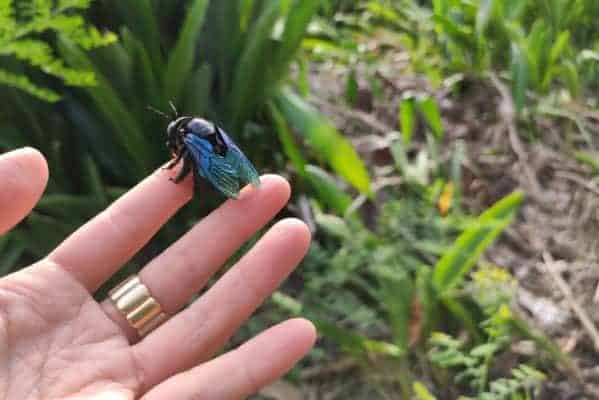
They do not lose their stingers after the attack and they can sting multiple times if the threat/intruder remains in the vicinity of the nest. It is best to stay away from their nests especially in spring and summer.
Try not to make any sudden movements if a carpenter bee lands on you. Just remain calm and wait for the bee to fly away. Their sting is as painful as any other type of bee.
We take a deep dive into this topic of carpenter bees and their stings in another article that would be worth a look if you are interested. The article is called, Do Carpenter Bees Sting And Does It Hurt?
11. Carpenter Bees Eat Pollen and Nectar
Like most other bee species, carpenter bees forage for pollen and nectar from flowering plants. The pollen and nectar provide them with their protein and carbohydrate sources.
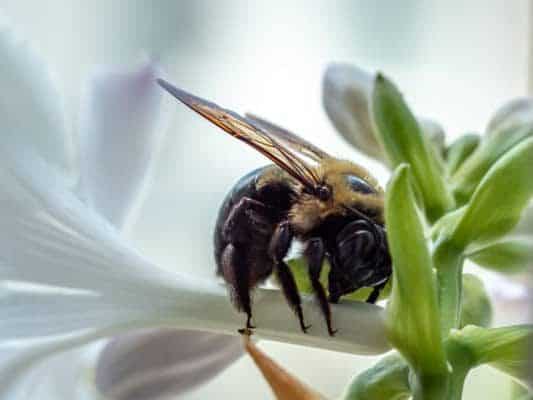
However, unlike the honey bees, they don’t make or store honey in their nests. Carpenter bees regurgitate nectar and mix it with pollen. The result is a ball of thick and denser “bee bread” than their smaller cousins, the honey bee species which make honey.
It has a cookie dough consistency, more like peanut butter. They leave the pollen and honey balls in the egg cells for the larva to feed on upon hatching. They usually regurgitate the nectar from flowers and mix it with pollen to form bee-bread.
12. Carpenter Bees in The United States Are In Two Genera
In the United States, carpenter bees are categorized into two genera—large carpenter bees (Xylocopa) and small carpenter bees (Ceratina).
Xylocopa
Due to their habit of drilling and excavating holes and tunnels in wood, the Xylocopa are the better known species, more than Ceratina.
The geographical distribution of the large carpenter bees in the United States covers the eastern and western, and parts of the southern United States.
In the Eastern part of the country, you will find the Xylocopa Virginica and Xylocopa Micans species. By far the most widely distributed species is X.virginica.
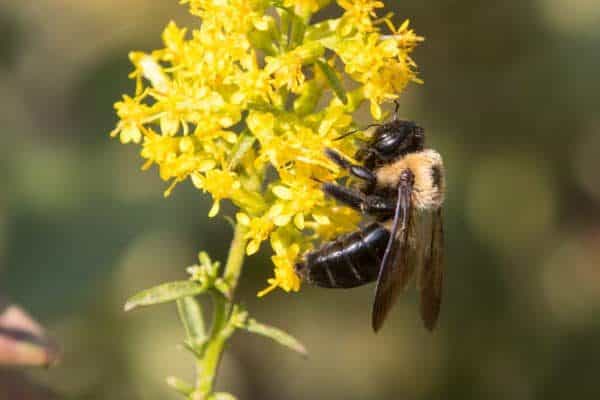
In the western United States, three more species are primarily dominant in distribution; X.sonorina, X.tabaniformis Opifex, and X.Californica. All these species are in the genus of large carpenter bees.
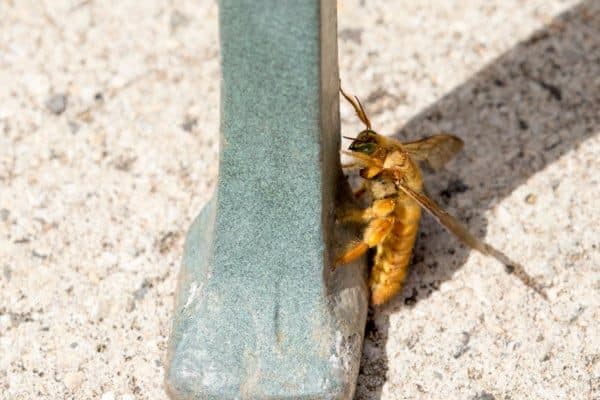
This is a male Sonorina Carpenter Bee (Xylocopa sonorina) found in the western United States.
Ceratina
This cosmopolitan bee genus is more often referred to as the small carpenter bee and it is closely related to the more familiar carpenter bees.
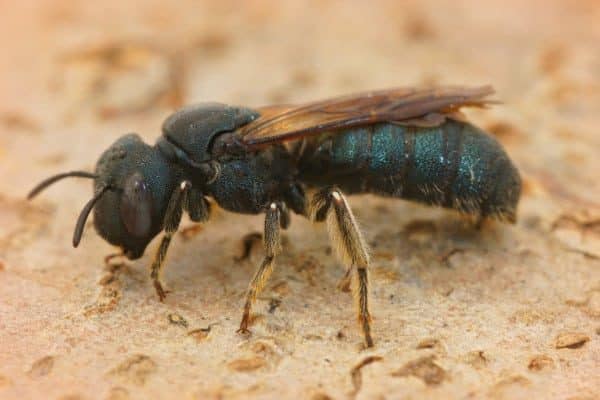
They are usually dark, shiny, even metallic, with fairly sparse body hairs and weak pollen carrying apparatus (scopa). They are mainly solitary and make nests in deadwood, stems, or pith.
They have however been known, in some cases, to live in a subsocial setup; with mothers caring for their larvae, and in some few instances where multiple females are found in a single nest. Daughters or sisters may form very small weakly eusocial colonies.
This means one bee forages and the other remains in the nest and lays eggs. The males guard the nests.
13. Ceratina Carpenter Bees In East Africa
In East Africa, more than 20 species of the small carpenter bees have been recorded, with three of the most common species of Ceratina being; Ceratina Lineola, Ceratina Lunata, and Ceratina Rufigastra.
In this region, the name bee is thought only to apply to honey bees and local people usually tend not to recognize carpenter bees as useful insects.
The carpenter bees are usually shiny black or metallic blue. They are mostly well sclerotized (armored) and robust.
They can be found in a wide range of habitats in East Africa such as natural forests, wetlands, marshlands, open habitats, protected areas, rangelands, farmlands, woodlands, woodlots (forest plantations), and riparian areas.
Quite interestingly, most species found in East Africa nest in self-made tunnels in woody materials on the ground, in walls of abandoned houses, or in the soil. As pollinators, most Ceratina bees in East Africa collect nectar and pollen from varying flowering crop species belonging to different plant families (are polylectic).
A few visit a narrower range of plants (are oligolectic). Among the plants and crops visited and efficiently pollinated are beans, cowpeas, simsim (sesame), apples, and coffee.
These bees also visit shrubs, trees, herbs, and lianas found in different habitats. The carpenter bee has a preference for visiting plant species with small yellow, white, green, milk-cream, and purple colored flowers.
14. Carpenter Bees Are Often Called Black Bees
In the United States, carpenter bees tend to be blacker than yellow and have a smooth shiny abdomen. They also have thick black hair on their hind legs.
Most species are all black or primarily black with some yellow or white markings. The top surface of the abdomen is mostly bare and shiny.
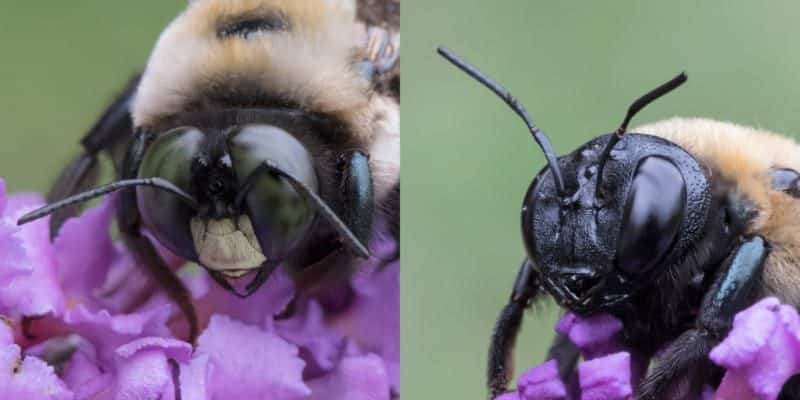
The male eastern caperenter bee (Xylocopa Virginica) has a yellow fur with a white marking on their face. The females’ face is black. Some species are also blue-black, green, or have a purple metallic sheen with a shiny, almost hairless abdomen.
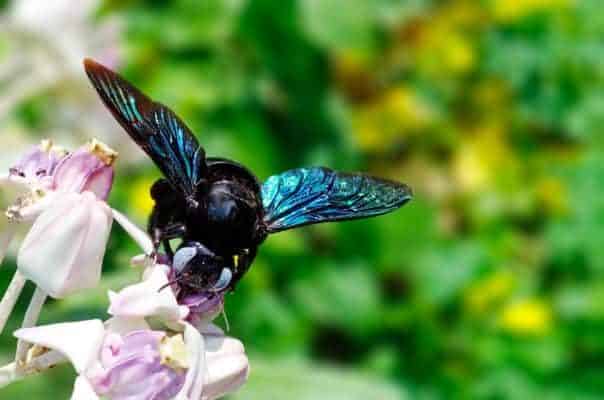
We actually have a full article discussing everything you might need to know about black bees. The article is Black Bees, You Need To Know The Good From The Bad.
15. Carpenter Bees Also Come In Blue
Numerous species of carpenter bees inhabit a broad range of ecosystems, from tropical, subtropical to temperate.
The blue carpenter bee is found throughout Southeast Asia, India, and southern China. They are known for being large and heavy and have the same behavioral characteristics as solitary bees.
They can reach up to (0.91 inches) 23mm. in length. The light blue hairs (pubescence, the scientific name for fuzz) covering the thorax region of this insect give it a striking blue color.
The sides of the abdomen are also covered by similar, though a finer and thinner coat of blue hairs. The males have a more subdued brown or greenish fuzz.
16. Carpenter Bees Live For About a Year
Carpenter bees are long lived and can be expected to live for far much longer than the honey bee species under normal circumstances.
Carpenter bees spend an average of 2 days as an egg, 15 days as larva, 4 days in the pre-pupa stage, and 15 days as a pupa.
Adults emerge in August, feed, and then return to the same tunnel to overwinter and begin the process over. The”expected” lifespan of a carpenter bee is one year. However, the bees may live for up to three years, with some having two generations living in the same nests.
We have an in-depth article that compares the life cycles of carpenter bees with both honey bees and bumblebees. The article is Carpenter Bees Vs Bumblebees Vs Honey Bees.
The Wrap Up
Carpenter bees are important pollinators of both native and agricultural plants in many parts of the world. Their beneficial role as pollinators far outweighs their destructive habits of drilling holes and nesting in our homes and outdoor furniture.
By doing preventive maintenance, most of the serious damage caused by these bees to our homes can be prevented.
Painting or applying wood varnish, caulking, and sealing off all crevices and spaces are some simple steps you can take to keep off potentially destructive bees.
They play a significantly useful role in (though at times not recognized) our ecosystems and their wide geographical presence in different habitats attests to this fact.
These gentle giants are commonly confused with bumblebees, but the simplest way of telling them apart is by noting that most carpenter bees have shiny abdomens, whereas bumblebees are completely covered by dense hair.
They are non-aggressive and moderately defensive. They don’t pose much of a threat if left alone. They just mind their own business of pollinating plants and building nests.
References
https://www.westernexterminator.com/blog/buzz-carpenter-bees/
https://www.orkin.com/stinging-pests/bees/carpenter-bee
https://en.wiktionary.org/wiki/polylectic
https://www.fs.fed.us/wildflowers/pollinators/pollinator-of-the-month/carpenter_bees.shtml
